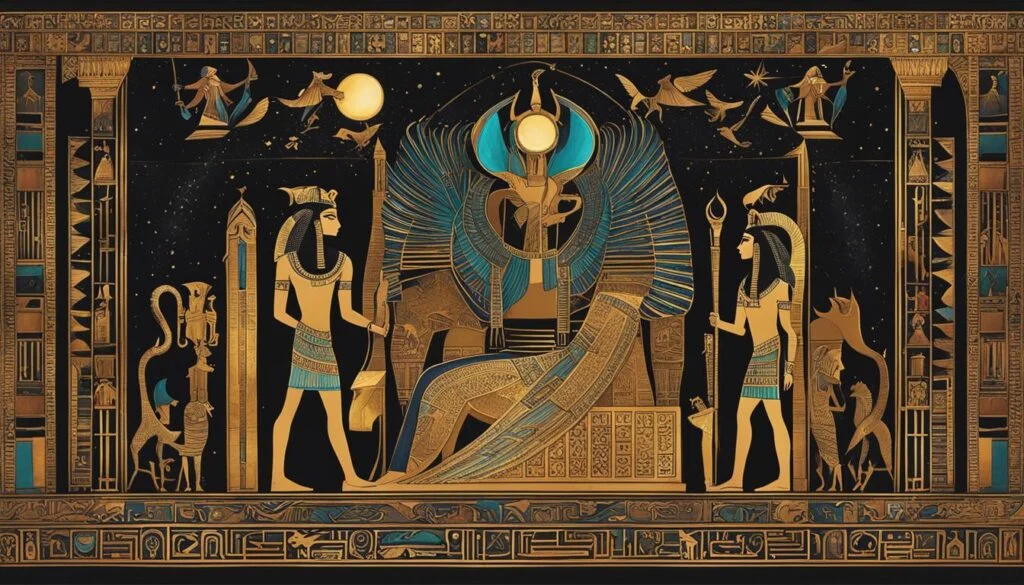Cats have always held a special place in our hearts, but did you know that in ancient Egypt, they were considered divine beings? One of the most revered feline figures in Egyptian mythology is Bastet, also known as Bast, the ancient Egyptian cat goddess. Let’s delve into the captivating world of this enchanting deity and explore her significance in Egyptian culture.
Key Takeaways:
- Bastet, the ancient Egyptian cat goddess, held great significance in Egyptian mythology.
- She was associated with protection, pleasure, good health, and fertility.
- Bastet was depicted as a long, slender woman with the head of a cat.
- Her worship and rituals involved temples, festivals, and the veneration of cat mummies.
- Bastet played a crucial role in Egyptian society as a protector and deity, especially in Lower Egypt.
The Origins and Evolution of Bastet
Bastet, the ancient Egyptian cat goddess, has a rich history that dates back to the Second Dynasty. As the daughter of Ra and sister of Sekhmet, Bastet held a significant position in Egyptian mythology.
Initially, Bastet was primarily worshipped in Lower Egypt. Depicted as a lioness goddess, she symbolized power and protection. However, over time, Bastet’s form and attributes underwent a transformation.
Her evolution led to a unique depiction that represented her strong connection with cats. Bastet emerged as a half-human, half-cat creature, with the head of a feline and the body of a woman. This shift in appearance solidified her association with the protective qualities and mystique of cats.
Bastet embodied diverse aspects of ancient Egyptian life. She represented protection, pleasure, fertility, and good health. Additionally, Bastet was connected to the moon, believed to be the eye of the moon and the eye of Ra.
The origins and evolution of Bastet’s image and powers demonstrate the fascinating journey of a goddess who held a prominent place in Egyptian mythology. Her transformation reflects the evolving beliefs and cultural shifts in ancient Egypt, with the cat goddess becoming an enduring symbol of protection and divine power.
Bastet’s Role as a Protector and Deity
Bastet, the ancient Egyptian cat deity, held a crucial role in Egyptian society as a revered protector and deity. Throughout the evolution of ancient Egypt, particularly in Lower Egypt, Bastet was worshipped for her power to safeguard households from evil spirits and disease. Egyptians believed that, much like cats kept vermin at bay, Bastet had the ability to ward off negative forces.
In some beliefs, Bastet’s benevolent power extended to protecting royalty, demonstrating her esteemed position as a guardian. She was closely associated with the rising sun, symbolizing her role in safeguarding and watching over the world. The worship of Bastet was deep-seated and widespread, with magnificent temples and vibrant festivals dedicated to honoring her presence.
Bastet’s influence and worship continue to resonate in select groups to this day, highlighting the enduring fascination with this Egyptian cat deity and the significant role she played in ancient Egyptian culture.
Bastet’s Relationships with Other Gods and Goddesses
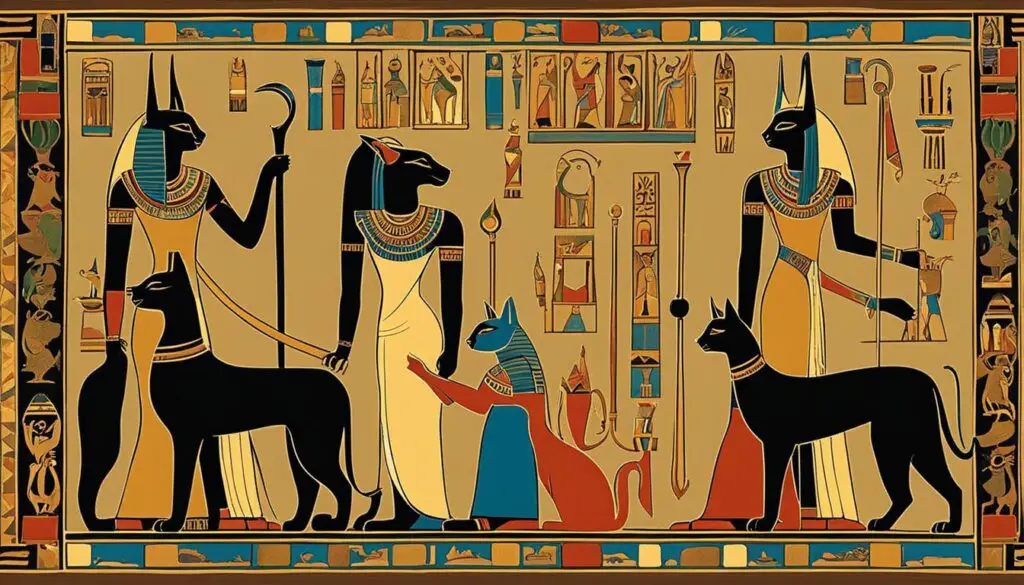
Bastet, the Egyptian cat goddess, had significant connections and associations with various gods and goddesses in the ancient Egyptian pantheon. These relationships further elevated her importance and influence within Egyptian mythology.
Daughter of Ra and Isis: Bastet was considered the daughter of Ra, the powerful sun god, and Isis, the goddess of magic and motherhood. She played a pivotal role in the family dynamic of these deities, embodying the characteristics and attributes inherited from both.
Eye of Ra: As the “eye of Ra,” Bastet held a special connection to her father. She was believed to be both an independent entity and a part of Ra, signifying her role in his protection and the maintenance of cosmic order.
Associated with Sekhmet: Another goddess closely linked to Bastet was Sekhmet, a lioness goddess associated with war and destruction. Bastet and Sekhmet were sisters and counterparts, sharing similar aspects as lioness deities. While Sekhmet represented the violent and wrathful side of protection, Bastet embodied a gentler and more nurturing form of defense.
Marriage to Ptah: Bastet’s role as a protector aligned with her union with Ptah, the god of architecture and craftsmanship. This marriage symbolized the harmonious collaboration between creativity and protection, highlighting the importance of both aspects in Egyptian culture.
Association with Hathor: Bastet was also associated with Hathor, the goddess of love, pleasure, music, and dance. Both goddesses shared similar attributes and represented various aspects of joy and celebration in Egyptian mythology.
Bastet’s Relationships and Influence
- The daughter of Ra and Isis
- The eye of Ra
- Linked to Sekhmet
- Married to Ptah
- Associated with Hathor
These connections and associations with other gods and goddesses enriched Bastet’s character and showcased her multifaceted nature within the Egyptian pantheon.
Image Description: Bastet Egyptian Cat Goddess
A depiction of Bastet, the Egyptian cat goddess, in her iconic form as a half-human, half-cat creature. She is shown with the head of a cat and a slender, graceful body, symbolizing her connection to feline energy and her role as a protector in Egyptian mythology.
Depictions and Symbols of Bastet
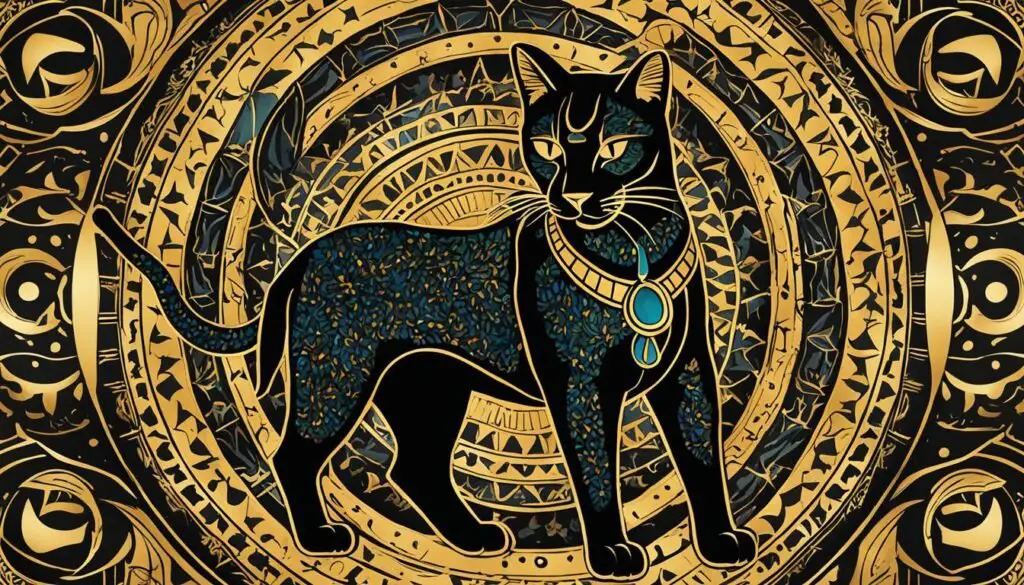
Bastet, the Egyptian cat deity, has been depicted in various forms throughout history, reflecting the evolution of her identity and significance. Initially portrayed as a lioness goddess, Bastet later transitioned into a cat or a cat-headed woman. In her cat-headed form, she often held a sistrum decorated with cats and an aegis adorned with a collar or lioness head.
Cats themselves became the primary symbol associated with Bastet, emphasizing her connection to feline qualities of agility, grace, and protection. Representing the reverence Egyptians had for cats, Bastet’s image was commonly carved from alabaster, a material often used for sacred items and perfume bottles.
Bastet’s symbols extended beyond feline imagery. She was visually and symbolically linked to the “eye of Ra,” a symbol representing the sun’s power and protection. Additionally, the Persea tree, associated with protection and the afterlife, was also connected to Bastet.
Bastet’s Worship and Rituals
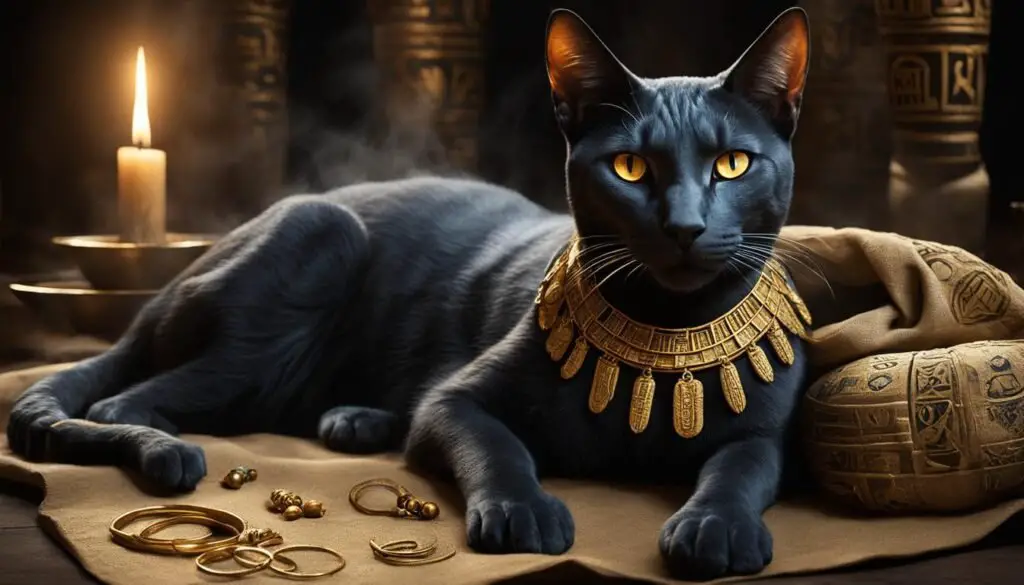
Bastet, the revered Egyptian cat goddess, held a significant place in ancient Egyptian society, receiving worship and reverence in various ways.
One of the most prominent forms of worship dedicated to Bastet was the celebration of annual festivals in her cult center city, Bubastis. These festivals were joyous occasions filled with music, dance, and intoxication. Egyptians believed that by participating in these festivities, they could invoke Bastet’s presence and receive her protection and blessings.
The worship of Bastet extended beyond the festivals. Egyptians prayed to her for protection from disease and evil spirits in their homes. To further secure her divine guardianship, statues of Bastet were prominently displayed, serving as sacred guardians and warding off potential thieves and malevolent forces.
One of the most intriguing and unique aspects of Bastet’s worship was the veneration of cats. Cats were considered sacred to Bastet, symbolizing her divine essence. They were treasured as household pets and treated with the utmost respect. In fact, the penalty for killing a cat, even accidentally, was death.
Temples dedicated to Bastet served as sanctuaries for these revered animals. These sacred spaces housed cat mummies, which were seen as offerings to the goddess and vessels for her divine energy. The presence of these cat mummies in the temples was a testament to the deep reverence and adoration that ancient Egyptians held for Bastet and her feline companions.
Throughout the worship and rituals associated with Bastet, the connection between humans and cats was celebrated and cherished. The symbiotic relationship between these beloved animals and the goddess herself exemplified the bond between the divine realm and the earthly world.
Major Myths and Legends of Bastet
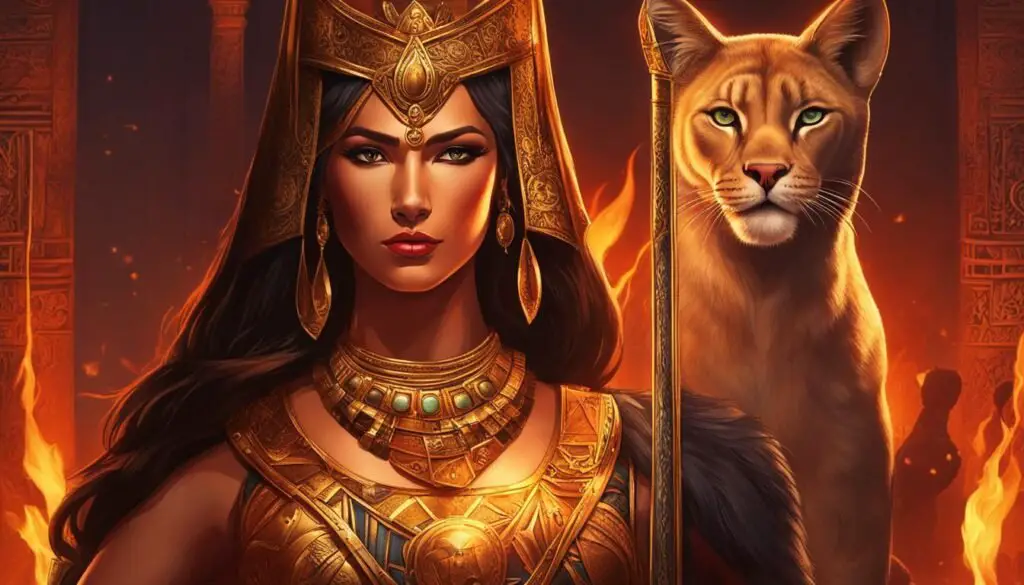
Bastet, the revered Egyptian cat goddess, has been immortalized in several captivating myths and legends that have captivated the imaginations of ancient Egyptians and continue to intrigue us today.
Slaying of Apep
One notable myth centers around Bastet’s valiant act of slaying Apep, the serpent god of darkness and chaos. In her feline form, Bastet courageously confronted Apep, successfully defeating him. This heroic feat ensured the survival of the sun’s light and the prosperity of crops, bringing harmony and abundance to the land.
Bastet and Sekhmet
In another myth, Bastet’s sister, Sekhmet, representing the destructive aspect of the sun, unleashed her fury upon humanity, causing widespread chaos and suffering. In a display of sisterly love and compassion, Bastet intervened and managed to pacify Sekhmet, preventing further devastation. This myth highlights Bastet’s role as a peacemaker and protector of humans.
The Genesis of Turquoise
One intriguing myth associated with Bastet originates from the city of Bubastis. According to this legend, it is believed that turquoise, a precious stone associated with protection and divine power, is actually the fallen menstrual blood of Bastet. The myth narrates that when the goddess menstruated, her blood instantly transformed into turquoise upon touching the ground, imbuing the stone with mystical qualities of beauty and vitality.
These myths and legends surrounding Bastet demonstrate her significant presence in Egyptian mythology, showcasing her heroic acts of courage, her role as a peacemaker, and the mystical origins of precious gemstones. They offer us a glimpse into the ancient beliefs and cultural significance of the Egyptian cat goddess, continuing to fascinate and inspire us today.
Conclusion
Bastet, the ancient Egyptian cat goddess, holds a significant place in Egyptian mythology, revered as a protector, deity, and symbol of fertility and good health. Throughout Egypt’s history, Bastet was deeply worshipped and cherished by the ancient Egyptians. Her transformation from a lioness goddess to a cat-headed deity reflects the cultural shifts and evolving beliefs of ancient Egypt.
Bastet’s relationships with other gods and goddesses, such as Ra, Isis, and Sekhmet, highlight her importance in the Egyptian pantheon. She was not only seen as a powerful deity but also as a nurturer and guardian. The symbols associated with Bastet, the rituals devoted to her worship, and the captivating myths and legends that surround her contribute to her enduring popularity in modern culture.
Today, the fascination with Bastet continues as people are drawn to her mysterious and awe-inspiring presence. The ancient Egyptian cat goddess, Bastet, remains an iconic figure, symbolizing the deep bond between humans and animals, and reminding us of the ancient wisdom and reverence for the natural world.
FAQ
Who is Bastet in Egyptian mythology?
Bastet, also known as Bast, is an ancient Egyptian cat goddess who was revered and worshipped as a protector and deity. She was the embodiment of a cat and held great significance in Egyptian society.
What were Bastet’s roles and attributes in Egyptian mythology?
Bastet was associated with protection, pleasure, good health, and fertility. She was regarded as a guardian and was believed to protect households from evil spirits and disease. Additionally, she was associated with the rising sun and had a special connection to Ra, the sun god.
How was Bastet depicted in ancient Egypt?
Bastet was initially depicted as a lioness goddess but later transitioned into a cat or cat-headed woman. In her cat-headed form, she often held a sistrum decorated with cats and an aegis adorned with a collar or lioness head. Cats themselves became the primary symbol associated with Bastet.
Did ancient Egyptians worship cats?
Yes, ancient Egyptians worshipped cats and considered them sacred. Cats were treasured as pets, and killing a cat, even accidentally, was punishable by death. Temples dedicated to Bastet held cat mummies and were sanctuaries for these revered animals.
What were some major myths and legends involving Bastet?
One notable myth is the slaying of Apep, an underworld serpent god associated with darkness and chaos, by Bastet in her cat form. She also played a role in stopping her sister Sekhmet’s vengeance upon humanity. Another myth suggests that turquoise is the fallen menstrual blood of Bastet.




